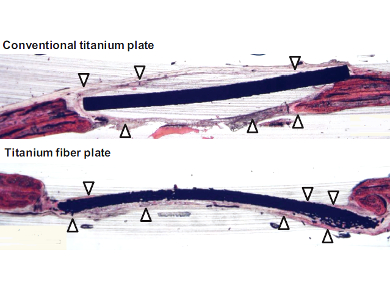Titanium plates are widely used in clinical settings because of their high bone affinity. However, owing to their high elastic modulus, these plates are not suitable for bone repair since their proximity to the bone surface for prolonged periods can cause stress shielding, leading to bone embrittlement.
Naoto Saito, Shinshu University, Matsumoto, Japan, and colleagues have prepared titanium fiber plates by molding titanium fibers into plates by simultaneously applying compression and shear stress at normal room temperature. These fiber plates can have an elastic modulus similar to that of bone cortex, and stress shielding will not occur even when the plate lies flush against the bone’s surface. Titanium fibers can form a porous structure suitable for cell adhesion and as a bone repair scaffold. Plate thickness, surface properties, porosity, Young’s modulus, strength, and other properties can be controlled by adjusting the titanium fiber thickness, fiber length, and the level of compression and shear stress.
The researchers combined a titanium fiber plate with osteoblasts and showed that it is better able to facilitate bone tissue repair than the conventional titanium plate when implanted in rat bone defects. Capable of being used in close contact with bone for a long time and of promoting bone repair, the researchers think titanium fiber plates will make great contributions to the clinical management of bone diseases, including bone fracture repair and bone regenerative medicine.
- Titanium Fiber Plates for Bone Tissue Repair,
Takashi Takizawa, Noboru Nakayama, Hisao Haniu, Kaoru Aoki, Masanori Okamoto, Hiroki Nomura, Manabu Tanaka, Atsushi Sobajima, Kazushige Yoshida, Takayuki Kamanaka, Kumiko Ajima, Ayumu Oishi, Chika Kuroda, Haruka Ishida, Satomi Okano, Shinsuke Kobayashi, Hiroyuki Kato and Naoto Saito,
Adv. Mater. 2017.
https://doi.org/10.1002/adma.201703608




